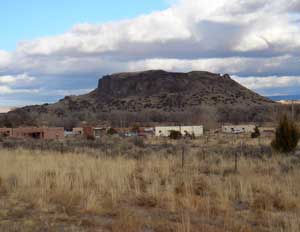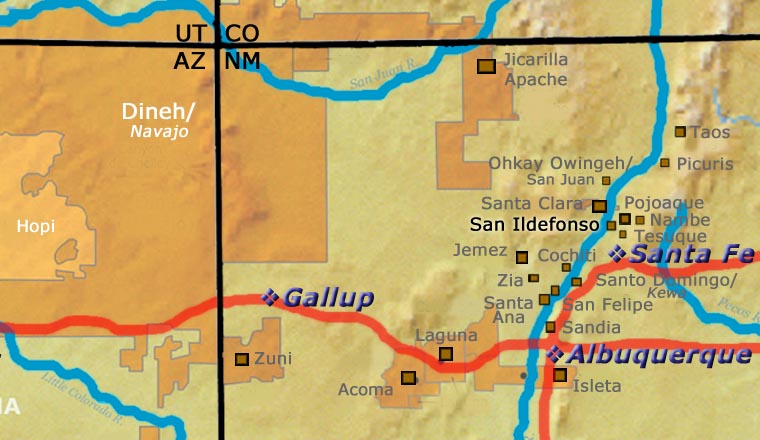
Rose Gonzales
1900-1989
San Ildefonso

Rose Gonzales was born into San Juan Pueblo in 1900. She and her sister, Pomasena, were educated at the Santa Fe Indian School and stayed there after their parents died during the swine flu epidemic of 1918. Mary Cata, an elderly female relative, adopted them and returned them to San Juan in 1919. In 1920 Rose married Robert Gonzales and the two sisters moved to Robert's home at San Ildefonso. Robert's mother, Ramona Sanchez Gonzales, taught Rose how to make pottery the traditional San Ildefonso way. Years later, Rose passed her knowledge on when she taught her son, Tse-Pé, his wife, Dora, and their daughter, Irene, the traditional way to make pots.
The early 1920s were an exciting time to be learning to make pottery at San Ildefonso. First Rose learned to make polished blackware, then she learned the new black-on-black technique and the older black-on-red technique. About 1929 Rose began "earnestly making pottery." She slowly perfected her polish, refining her technique on both blackware and redware. Coming as she did from San Juan Pueblo, Rose made especially fine redware.
Rose said it was around 1930 that her husband was out deer hunting and came across an ancient carved pot shard. He brought it home and she studied it, trying to work out how it had been made before carving her first piece. In her words: "I fired it and it came out nice and I started carving." For that reason she is credited as being the innovator of deep carved pottery at San Ildefonso.
Rose used a sharp knife and chisel to carve her pots. After a while she began sanding the edges to create a "cameo" style. She made pots with both square and rounded edges on her carved lines. While she was always selling her pots Rose was also feeding up to eleven people at her kitchen table. During the 1930s and 40s she traded many of her pots for food. When she got older, she sometimes collaborated with her son, Tse-Pé, especially when she was working with two-tone pots.
Rose mostly made black, red and two-tone jars, bowls, wedding vases, cylinders, vases, canteens, plates and bird effigy bowls. Her favorite designs were carved or painted birds, clouds, avanyus, kiva steps, thunderbirds and seeds uncurling. Rose participated many times in shows like the Santa Fe Indian Market, Eight Northern Indian Pueblos Arts and Crafts Show, the Gallup Intertribal Ceremonial and the New Mexico State Fair, winning numerous First, Second and Third Place ribbons over the years. Rose passed away in 1989.
Some Exhibits that Featured Works by Rose
- Breaking the Surface: Carved Pottery Techniques and Designs. Heard Museum. Phoenix, Arizona. October 2004 - October 2005
- Hold Everything! Masterworks of Basketry and Pottery from the Heard Museum. Heard Museum. Phoenix, Arizona. November 1, 2001 - March 10, 2002
- Recent Acquisitions. Heard Museum. Phoenix, Arizona. July 12, 1997 - January 1998
- 1978 Heard Museum Guild Indian Arts and Crafts Exhibit. Heard Museum. Phoenix, Arizona. November 24 - December 2, 1978
100 West San Francisco Street, Santa Fe, New Mexico 87501
(505) 986-1234 - www.andreafisherpottery.com - All Rights Reserved

San Ildefonso Pueblo
San Ildefonso Pueblo is located about twenty miles northwest of Santa Fe, New Mexico, west of Pojoaque, south of Santa Clara and straddling the Rio Grande. Although their ancestry has been traced to prehistoric pueblos in the Greater Mesa Verde area, the prehistoric pueblo at Tsankawi, in a non-contiguous parcel of Bandelier National Monument, is their most recent ancestral home. Tsankawi abuts the reservation on its northwest side.
Franciscan monks named the village after San Ildefonso and in 1617, forced the tribe to build a mission church on top of the village's main kiva. Before that the village was known as Powhoge, "where the water cuts through" (in Tewa). Today's pueblo was established as long ago as the 1300s. When the Spanish arrived in 1540, they estimated the village population at about 2,000.
That mission was destroyed during the Pueblo Revolt of 1680 and when Don Diego de Vargas returned to reclaim San Ildefonso in 1694, he found virtually all the Tewa people camped out on top of nearby Black Mesa. After an extended siege the two sides negotiated a treaty and the people returned to their villages. However, the next 250 years were not so good for them.
The swine flu pandemic of 1918 reduced the pueblo's population to about 90. Their population has grown to more than 600 since but the only economic activity available on the pueblo itself involves creating art in one form or another. The only other work is off-pueblo. San Ildefonso's population is small compared to neighboring Santa Clara Pueblo, but the pueblo maintains its own religious traditions and ceremonial feast days.
San Ildefonso is most known for being the home of the most famous Pueblo Indian potter, Maria Martinez. Many other excellent potters from this pueblo have produced quality pottery, too, among them: Blue Corn, Tonita and Juan Roybal, Dora Tse Pe and Rose Gonzales. Of course, the descendants of Maria Martinez are still important pillars of San Ildefonso's pottery tradition. Maria's influence reached far and wide, so far and wide that even Juan Quezada of the Mata Ortiz pottery renaissance in Chihuahua, Mexico, came to San Ildefonso to learn from her.
100 West San Francisco Street, Santa Fe, New Mexico 87501
(505) 986-1234 - www.andreafisherpottery.com - All Rights Reserved

